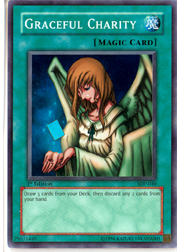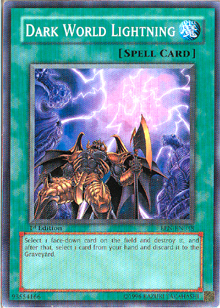“In Dark World, lightning never needs to strike twice.”
Building on our discussion of costs from last week, this week we will look at several cards in the Yu-Gi-Oh! TCG and dissect the way they work. Specifically, we’ll determine if they have a cost and what you need to give up in order to pay it. For the Nobles of Dark World, this is very important. Discarding them for the wrong reason means losing their effects, and any player running the Nobles of Dark World simply can’t allow this to happen.
Graces of Dark World
 Let’s examine the most recent method of discarding cards that was reintroduced into Advanced format play: Graceful Charity. When you activate it, you simply declare its activation and then await a response from your opponent. For now, Graceful Charity does nothing but wait. After you and your opponent have finished building the chain and begun to resolve it, you’ll come back to your Graceful Charity, resolving it by drawing three cards from your deck, followed by discarding any two cards from your hand. When this action is complete, you’ve finished resolving Graceful Charity.
Let’s examine the most recent method of discarding cards that was reintroduced into Advanced format play: Graceful Charity. When you activate it, you simply declare its activation and then await a response from your opponent. For now, Graceful Charity does nothing but wait. After you and your opponent have finished building the chain and begun to resolve it, you’ll come back to your Graceful Charity, resolving it by drawing three cards from your deck, followed by discarding any two cards from your hand. When this action is complete, you’ve finished resolving Graceful Charity.
When did the discard occur? Did you discard before you activated Graceful Charity? No. Discarding doesn’t take place until you’re resolving its effect, which occurs after you activated Graceful Charity, and not before. Looking at what we know about costs, would this make it an activation cost? Not a chance! Discarding after we activate our card means that the action is not an activation cost.
Now I’ll play with your minds by taking you on a journey into the fictitious realm of Shadow Yu-Gi-Oh!—a world where the Graceful Charity that we all know and love has twisted into Conditional Charity. In the Shadow Yu-Gi-Oh! world, Conditional Charity says “Discard 2 cards. Draw 3 cards from your Deck.”
How does this differ from our regular Graceful Charity? You will notice that the first line of this fictitious card tells us to discard two cards from our hand. Does the format of this text look familiar? It’s the very same format we saw used on Lightning Vortex last week. We recognize this as an activation cost, because it is paid before the activation of the card. You can’t activate the fictitious Conditional Charity without two cards in your hand that you can discard to pay its activation cost. In this Shadow Yu-Gi-Oh! world, Dark World monsters discarded through Conditional Charity would be discarded to pay an activation cost. This would displease them greatly, because it would not satisfy their effect.
Thankfully for us, we live in the real world and don’t have this problem. In the real world, discarding a Dark World monster like Sillva, Warlord of Dark World for Graceful Charity will activate the Dark World monster’s effect. As we’ve just learned, this discard is not a cost, which makes it perfect to use with the Nobles of Dark World.
One Fatal Strike
 Now let’s examine a support card designed to function with the Nobles of Dark World, Dark World Lightning. Its text reads, “Select 1 face-down card on the field and destroy it, and after that, select 1 card from your hand and discard it to the Graveyard.” When we use this card, we know that we will be discarding one card from our hands, but does this discarded card count as a cost?
Now let’s examine a support card designed to function with the Nobles of Dark World, Dark World Lightning. Its text reads, “Select 1 face-down card on the field and destroy it, and after that, select 1 card from your hand and discard it to the Graveyard.” When we use this card, we know that we will be discarding one card from our hands, but does this discarded card count as a cost?
Consider the process involved. The first thing this card will do is destroy one face-down card on the field. After that, you will select one card from your hand and discard it. Now let’s take this process and apply what we know about activation costs. Do you discard one card from your hand before or after you activate Dark World Lightning? Clearly, the first thing you do is destroy a face-down card on the field, so it’s impossible to say that you discard first. That means the discard for Dark World Lightning is not an activation cost. If discarding one card from your hand was a cost, it would be the very first thing you’d do, even before activating the card. We can tell from the order of the effect that this is clearly not the case.
Let’s examine Raigeki Break, another card with a similar ability. The text reads, “Discard 1 card from your hand. Destroy 1 card on the field.” The first action you perform is discarding one card from your hand, which is what you must spend in order for Raigeki Break to destroy one card on the field. This occurs before you activate the card and is indeed the activation cost, so discarding a Dark World monster with Raigeki Break will not satisfy the Dark World Nobles’ effect.
Selection: A Cost?
We’re going to wrap up this week with a look into cards that may seem like a cost, but actually are not. These cards are written in a way that presents them like other cards with activation costs, but their demands have no actual cost at all. It sounds really bizarre, so let’s look at some examples.
The first line of Feather Shot says, “Select 1 face-up ‘Elemental Hero Avian’ on your side of the field to activate this card.” Reading this text, it becomes clear that you must select one face-up Elemental Hero Avian in order to activate the card, but does this mean it is a cost?
Think about it like this—are you giving up anything as payment by doing this? Does selecting a face-up Elemental Hero Avian cost you anything? You don’t lose any cards or life points, nor do you remove any cards in your graveyard from play. Instead, all you do is say, “This is my Elemental Hero Avian that I’m going to use for this effect.” Without a payment of any kind, this type of effect text cannot be a cost.
Let’s take another example. Your Elemental Hero Clayman is being attacked by your opponent’s monster, so you activate your set Clay Charge, which asks you to “destroy the attacking monster and the selected ‘Elemental Hero Clayman’ to inflict 800 points of damage to your opponent’s Life Points.” Looking at this line of text, it sounds a bit like a cost, doesn’t it? It’s similar to the wording that’s used by the LV monsters and Spell Vanishing, and on those cards, it is an activation cost for their respective effects. But does anything make Clay Charge different?
Clay Charge tells you to destroy your Elemental Hero Clayman and your opponent’s attacking monster. It is perfectly fine to destroy your own monster to pay a cost, but destroying your opponent’s monster is entirely different. It isn’t possible for you to destroy your opponent’s monster as a cost, because by doing this, you aren’t paying anything.
I’m sure that some of you are thinking, “Hey, but what about Lava Golem? I tribute my opponent’s monsters to summon it. Isn’t that a cost?” Well, yes, you do tribute two of your opponent’s monsters. However, that action is not an activation cost. It’s similar to the cost paid when you tribute summon a monster, an action that is not an activated effect and has no spell speed. Lava Golem is truly unique in this way.
Next week, we will wrap things up by bringing in the Dark World monsters and looking at even more complicated effects. Be sure to return here for more!
Until next time, send all comments to Curtis@Metagame.com.